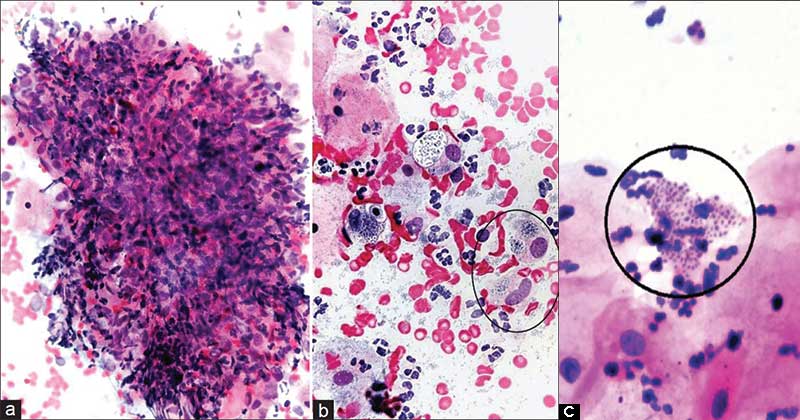
Image: Granuloma inguinale (donovanosis) in a conventional Pap test.
A: Granulomatous inflammation is shown with epithelioid histiocytes and lymphocytes.
B: The organisms (Donovan bodies) can be seen in thin-walled intracytoplasmic vacuoles (circle ). (Pap stain, Mag ×200 in a and ×400 in b).
C: Macrophages show numerous safety pin-shaped structures with polar thickening of chromatin (Donovan bodies) and a halo around them (circle) (Pap, ×100).
Image Source: PathologyOutlines.com
Interesting Science Videos
Some of the characteristics are as follows:
Basic Characteristics |
Properties (Klebsiella granulomatis) |
| Capsule | Positive (+ve) |
| Catalase | Positive (+ve) |
| Citrate | Positive (+ve) |
| Flagella | Negative (-ve) |
| Gram Staining | Gram-negative |
| H2S | Negative (-ve) |
| Indole | Negative (-ve) |
| Motility | Non-motile |
| MR (Methyl Red) | Negative (-ve) |
| Nitrate Reduction | Negative (-ve) |
| Oxidase | Positive (+ve) |
| Shape | Pleomorphic rods (coccobacillus) with rounded ends.
Occur singly or in clusters |
| Urease | Positive (+ve) |
| VP (Voges Proskauer) | Positive (+ve) |
Fermentation of |
|
| Arabinose | Negative (-ve) |
| Dulcitol | Negative (-ve) |
| Glucose | Positive (+ve) |
| Lactose | Positive (+ve) |
| Malonate | Positive (+ve) |
| Raffinose | Negative (-ve) |
| Rhamnose | Positive (+ve) |
| Xylose | Positive (+ve) |
Enzymatic Reactions |
|
| Lysine decarboxylase | Positive (+ve) |
| ONPG (β-galactosidase) | Positive (+ve) |
References
- Bergey’s Manual of Systematic Bacteriology Volume 2: The Proteobacteria, Part B:The Gammaproteobacteria
- https://www.sciencedirect.com/topics/medicine-and-dentistry/klebsiella-granulomatis
- https://www.bode-science-center.com/center/relevant-pathogens-from-a-z/klebsiella-granulomatis.html
- https://www.ncbi.nlm.nih.gov/books/NBK513306/
- https://www.britannica.com/science/Calymmatobacterium-granulomatis
- https://www.ncbi.nlm.nih.gov/pmc/articles/PMC4522720/
- http://web2.uwindsor.ca/courses/biology/fackrell/Microbes/5780.htm
- https://jcm.asm.org/content/jcm/35/11/2915.full.pdf
- http://www.antimicrobe.org/b108.asp
- https://www.microbiologyresearch.org/docserver/fulltext/jmm/46/7/medmicro-46-7-579.pdf?expires=1555736534&id=id&accname=guest&checksum=4DEEE3D33BE3D87ED0A3400A1E5EAE10
